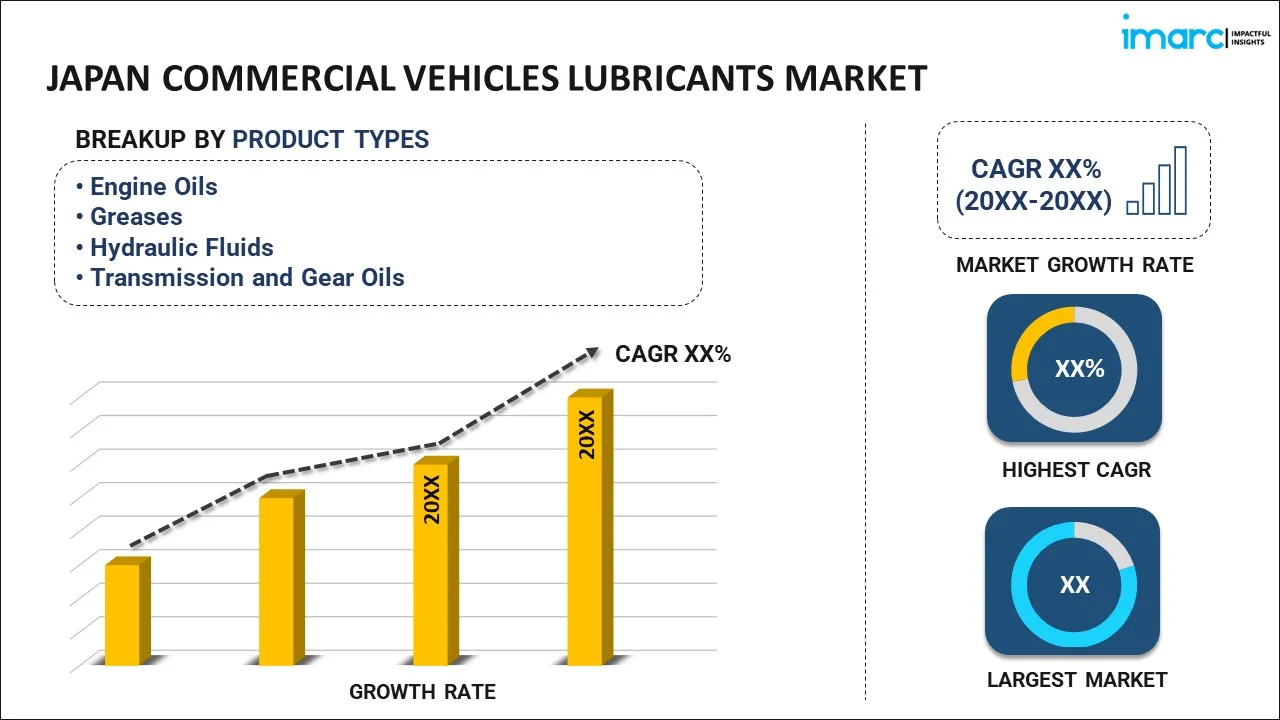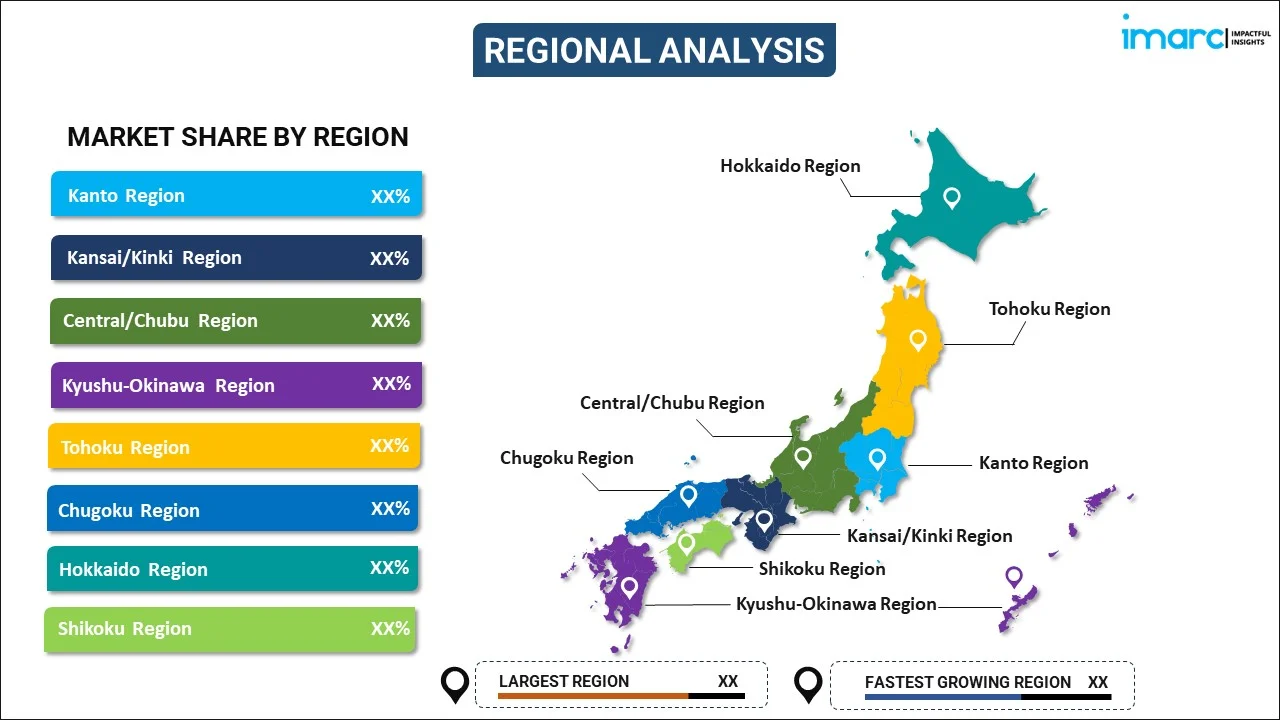
Japan Commercial Vehicles Lubricants Market Report by Product Type (Engine Oils, Greases, Hydraulic Fluids, Transmission and Gear Oils), and Region 2025-2033
Market Overview:
Japan commercial vehicles lubricants market size reached USD 530.0 Million in 2024. Looking forward, IMARC Group expects the market to reach USD 620.0 Million by 2033, exhibiting a growth rate (CAGR) of 1.7% during 2025-2033. The expansion and growth of the logistics and transportation sector, primarily due to the increase in e-commerce activities, is driving the commercial vehicles lubricants market growth in Japan.
|
Report Attribute
|
Key Statistics
|
|---|---|
|
Base Year
|
2024 |
|
Forecast Years
|
2025-2033
|
|
Historical Years
|
2019-2024
|
| Market Size in 2024 | USD 530.0 Million |
| Market Forecast in 2033 | USD 620.0 Million |
| Market Growth Rate (2025-2033) | 1.7% |
Commercial vehicles lubricants are specialized oils and fluids designed to optimize the longevity and performance of vehicles used for business purposes. These vehicles include trucks, buses, vans, and other industrial vehicles that are crucial for transporting goods and people. Commercial vehicles operate under demanding conditions, such as long-haul transportation, stop-and-go urban driving, and heavy payloads. Lubricants for these vehicles are formulated to withstand high temperatures, heavy loads, and extended service intervals. They provide essential functions like reducing friction, cooling engine components, and protecting against wear and corrosion. Key types of commercial vehicle lubricants include engine oils, transmission fluids, gear oils, and greases. Engine oils are critical for maintaining the efficiency and durability of the engine, while transmission fluids and gear oils ensure smooth gear shifting and protect the drivetrain. Greases are used to lubricate various components, such as wheel bearings and chassis parts.
Japan Commercial Vehicles Lubricants Market Trends:
The commercial vehicles lubricants market is being primarily driven by an upswing in the transportation industry, substantially attributed to the rapid expansion of e-commerce platforms, triggering an increased demand for freight transport in Japan. Simultaneously, the ongoing growth in infrastructure development projects acts as a catalyst, urging a progressive augmentation in the sales of commercial vehicles. In this context, escalating vehicle count translates to a higher demand for lubricants, aiming to ensure optimal vehicle performance by reducing friction and wear and tear. Moreover, evolving environmental standards and norms are imposing stringent emission regulations on commercial vehicles, propelling advancements in lubricant formulations. These advancements are crucial for complying with regulatory mandates, reflecting a parallel surge in eco-friendly and high-performance lubricant solutions. Furthermore, the rising awareness about the substantial role of lubricants in extending vehicle lifespan and reducing operational costs is influencing fleet owners to invest more in quality products. Apart from this, the synergistic effect of economic growth, industrial activities, environmental regulations, and advancements in lubricant technologies is thus shaping the trajectory of the commercial vehicles lubricants market in Japan.
Japan Commercial Vehicles Lubricants Market Segmentation:
IMARC Group provides an analysis of the key trends in each segment of the market, along with forecasts at the country level for 2025-2033. Our report has categorized the market based on product type.
Product Type Insights:

- Engine Oils
- Greases
- Hydraulic Fluids
- Transmission and Gear Oils
The report has provided a detailed breakup and analysis of the market based on the product type. This includes office engine oils, greases, hydraulic fluids, and transmission and gear oils.
Regional Insights:

- Kanto Region
- Kansai/Kinki Region
- Central/ Chubu Region
- Kyushu-Okinawa Region
- Tohoku Region
- Chugoku Region
- Hokkaido Region
- Shikoku Region
The report has also provided a comprehensive analysis of all the major regional markets, which include Kanto Region, Kansai/Kinki Region, Central/ Chubu Region, Kyushu-Okinawa Region, Tohoku Region, Chugoku Region, Hokkaido Region, and Shikoku Region.
Competitive Landscape:
The market research report has also provided a comprehensive analysis of the competitive landscape. Competitive analysis such as market structure, key player positioning, top winning strategies, competitive dashboard, and company evaluation quadrant has been covered in the report. Also, detailed profiles of all major companies have been provided. Some of the key players include:
- AKT Japan Co. Ltd.
- Chugoku Kogyo Co. Ltd.
- Cosmo Energy Holdings Co. Ltd.
- ENEOS Corporation (ENEOS Holdings Inc.)
- ExxonMobil Corporation
- Fuchs Petrolub SE
- Idemitsu Kosan Co. Ltd.
- Japan Sun Oil Company Ltd. (SUNOCO Inc.)
- Mitasu Oil Corporation
(Please note that this is only a partial list of the key players, and the complete list is provided in the report.)
Japan Commercial Vehicles Lubricants Market Report Coverage:
| Report Features | Details |
|---|---|
| Base Year of the Analysis | 2024 |
| Historical Period | 2019-2024 |
| Forecast Period | 2025-2033 |
| Units | Million USD |
| Scope of the Report | Exploration of Historical and Forecast Trends, Industry Catalysts and Challenges, Segment-Wise Historical and Predictive Market Assessment:
|
| Product Types Covered | Engine Oils, Greases, Hydraulic Fluids, Transmission and Gear Oils |
| Regions Covered | Kanto Region, Kansai/Kinki Region, Central/ Chubu Region, Kyushu-Okinawa Region, Tohoku Region, Chugoku Region, Hokkaido Region, Shikoku Region |
| Companies Covered | AKT Japan Co. Ltd., Chugoku Kogyo Co. Ltd., Cosmo Energy Holdings Co. Ltd., ENEOS Corporation (ENEOS Holdings Inc.), ExxonMobil Corporation, Fuchs Petrolub SE, Idemitsu Kosan Co. Ltd., Japan Sun Oil Company Ltd. (SUNOCO Inc.), Mitasu Oil Corporation, etc |
| Customization Scope | 10% Free Customization |
| Post-Sale Analyst Support | 10-12 Weeks |
| Delivery Format | PDF and Excel through Email (We can also provide the editable version of the report in PPT/Word format on special request) |
Key Questions Answered in This Report:
- How has the Japan commercial vehicles lubricants market performed so far and how will it perform in the coming years?
- What has been the impact of COVID-19 on the Japan commercial vehicles lubricants market?
- What is the breakup of the Japan commercial vehicles lubricants market on the basis of product type?
- What are the various stages in the value chain of the Japan commercial vehicles lubricants market?
- What are the key driving factors and challenges in the Japan commercial vehicles lubricants?
- What is the structure of the Japan commercial vehicles lubricants market and who are the key players?
- What is the degree of competition in the Japan commercial vehicles lubricants market?
Key Benefits for Stakeholders:
- IMARC’s industry report offers a comprehensive quantitative analysis of various market segments, historical and current market trends, market forecasts, and dynamics of the Japan commercial vehicles lubricants market from 2019-2033.
- The research report provides the latest information on the market drivers, challenges, and opportunities in the Japan commercial vehicles lubricants market.
- Porter's five forces analysis assist stakeholders in assessing the impact of new entrants, competitive rivalry, supplier power, buyer power, and the threat of substitution. It helps stakeholders to analyze the level of competition within the Japan commercial vehicles lubricants industry and its attractiveness.
- Competitive landscape allows stakeholders to understand their competitive environment and provides an insight into the current positions of key players in the market.
Need more help?
- Speak to our experienced analysts for insights on the current market scenarios.
- Include additional segments and countries to customize the report as per your requirement.
- Gain an unparalleled competitive advantage in your domain by understanding how to utilize the report and positively impacting your operations and revenue.
- For further assistance, please connect with our analysts.
 Inquire Before Buying
Inquire Before Buying
 Speak to an Analyst
Speak to an Analyst
 Request Brochure
Request Brochure
 Request Customization
Request Customization




.webp)




.webp)












